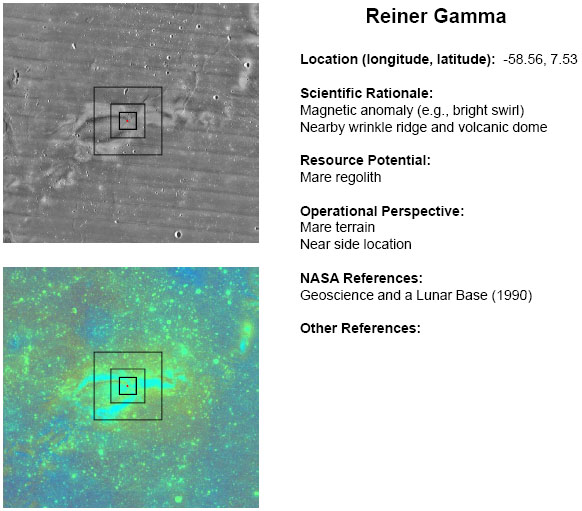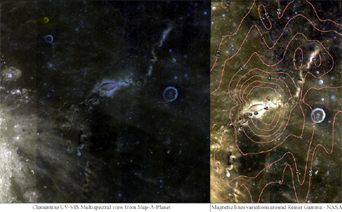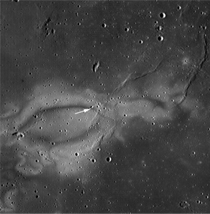RoI - Reiner Gamma
Contents
Reiner Gamma
(Tier 2 Region of Interest for Constellation Program)
Official NASA Overview

source: NASA Cx-LROC Tier 2 Targets (PDF); see expanded details below
Scientific Rationale
The Reiner Gamma Formation (RGF) is just one of several, swirl-like markings that can be found on the lunar surface. Located some 117 km west of Reiner crater, the main oval shape measures approximately 40 km x 20 km, with a tail-extension further eastwards measuring about ~ 40 km. Other swirl-like markings associated close to the oval's tail-like region extend in a north-eastward's direction by about ~ 135 km, while from the head-like region, they measure some ~ 200 km in a south-westward's direction.
Magnetic, cometary or electrical?
In 1972, two small sub-satellites that orbited the Moon (originally released by Apollo's 15 and 16 in 1971 and 1972 respectively) unexpectedly discovered that the swirl was highly magnetised. But what was causing it, and also with subsequent, other swirl-like markings on the Moon later discovered to have concentrated magnetic fields around them to behave this way? One main hypothesis proposed that the concentration of magnetic fields is generally due to the blast created from impactors striking the lunar surface at anti-podal points to the swirl locations: causing electrically-conducted gas to converge global magnetic fields there. As the Moon's early core then cooled, and the global magnetic field faded over time, concentrated magnetism at the swirls remained as we see them today. While the hypothesis may be applicable as to why other swirl-like regions on the Moon have associated impact points anti-podal to them (as well as having optically-mature material in their surrounds), the RGF appears to have neither characteristic.
Whatever the cause as to why Reiner Gamma physically formed, the existance of the highly concentrated magnetic fields may be responsible for its unusual appearance. Results from the Japanese Kaguya/Selene spacecraft support the hypothesis that such fields can slow down and deflect ions in the solar wind flux - known to darken the lunar soil, while earth-based telescopic and Clementine multispectral data point to the area having quite an immature make-up (age for its emplacement could be quite recent). Ions constantly bombard the lunar surface globally, however, the pre-existing magnetic fields around Reiner Gamma could thus be preserving the high-albedo material at certain lines, and, moreover, may be behaving like mini-magnetospheres - as discovered recently in data from the Indian Chandrayaan-1 mission (see Wieser et al below in Bibliography). Both instances would allow for focusing of 'over' and 'under' maturation processes of the local soil: for example, in the dark lanes and bright regions seen - the effects of which could continually be maintaining its appearance since it formed.
An alternative hypothesis for the RGF, however, may be due to more recent cometary impacts or meteorite swarm encounters that 'scoured' (surficial mass removal) away the topmost surface layers. These instantly produced a fresh, more immature content to mix with the target soil, leaving their unconsolidated, high-albedo material to 'shine' through. This hypothesis may also be responsible for the magnetic fields detected by above missions as overheating effects; due to the initial impactors smashing into the topmost layer, and their ability to make the local material magnetised. If this is correct, then the magnetic fields are continually protecting, and shielding, the fresh cometary/meteorite material from becoming darkend (aka: mini-magnetospheres, focusing processes mentioned above).
One final, more recent, hypothesis (see Garrick-Bethell 2010 below in Bibliography) involves the effect of inferred electrical fields - existing alongside the magnetic fields - on dust-lofting of material in the region. This mechanism involves raising and movement of fine-grained, feldspathic, highland material above the surface as it becomes positively (negatively) charged - particularly at terminator times; allowing its dusty make-up to produce darker regions where the net electrical field value is zero and brighter regions where they are not.
The real mechanism behind such swirl-like formations, however, is thus very complex, but one certainty about them all is that they overprint the topography they lie on. Is this an indication, perhaps, that they might be quite thin, or, are they the result of deeper surface interactions with normal processes within a region that isn't quite fully understood? In either scenario, however, swirl-like apparitions that occur on both the maria (generally characterised by high-albedo, complex markings) and the highlands (seen as simpler shapes such as loops or bright spots) are areas that will benefit from future missions - robotic or manned. The Reiner Gamma ROI region thus has the potential to answer questions about space weathering, maturity of soils, origin of magnetic (or mini-magnetospheric) anomalies, solar wind conditions, and areas where posible future lunar bases may be set up in these 'unique' locations.- JohnMoore2
NASA References
- Geoscience and a Lunar Base (1990) -- A Comprehensive Plan for Lunar Exploration -- Proceedings of a workshop sponsored by NASA, and held at the Lunar and Planetary Institute, Houston, Texas, August 25-26, 1988.
|
Left: Clementine UV-VIS Multispectral image from Map-A-Planet. |
Additional Information
Strong magnetic anomlous lunar regions:
- Area around Descartes mountains ~ south-east of Apollo 16 represents one of the strongest, single magnetic anomalies on the nearside (having, as well, unusually high-albedo markings).
- North-west periphery of SPA basin (antipodal to Imbrium and Serenitatis).
- Within Mare Ingenii (near the Imbrium antipode).
- East of Mare Marginis (near the Orientale antipode) on the farside.
- See also High Albedo Swirls on the Moon's Surface
- IAU page Reiner Gamma
LROC Links
- Featured Image -- Reiner Gamma Constellation Region of Interest
LPOD Articles
No Difference in Rays, Brightness at Noon.
General Bibliography
- Syal, M. B. and Schultz, P. H. (2015). Cometary impact effects at the Moon: Implications for lunar swirl formation - Icarus, Volume 257, 1 September. Pages 194–206. 2015.
- Bamford, R. A. et al (2012). Mini-magnetospheres above the lunar surface and the formation of lunar swirls (PDF) – Physical Review Letters (Accepted – June, 2012).
- Garrick-Bethell, I. (2010). Spectral Properties of Lunar Swirls and Their Formation by Dust Transport - 41st Lunar and Planetary Science Conference. 2010.
- Kramer, G. et al (2010). An Investigation into the Effects of the Magnetic Anomaly on Regional Space Weathering at Mare Ingenii and its Influence on the Spectra of the Basalts and Lunar Swirls - 41st Lunar and Planetary Science Conference. 2010.
- Lawrence, J. (2010). Coordinated Mini-RF and LROC Observations of the Lunar Surface - 41st Lunar and Planetary Science Conference. 2010.
- Wieser, M. (2010). et al First Observation of a Mini-magnetosphere Above a Lunar Magnetic Anomaly Using Energetic Neutral Atoms - Geophysical Research Letters, Vol. 37, L05103, 4 PP., doi:10.1029/2009GL041721, 2010.
- Kramer, G. (2009). et al The Lunar Swirls - A White Paper to the NASA Decadel Survey, 2009.
- Hood, P. C.. (2009). Lunar Magnetism - Lunar Reconnaissance Orbiter Science Targeting Meeting, 2009.
- Srivastava, N. (2009). Spectral Reflectance Studies for Maturation Trends in a Mare and Highland - 40th Lunar and Planetary Science Conference. 2009.
- Halekas, J. S. (2008). Density Cavity Observed Over a Strong Lunar Crustal Magnetic Anomaly in the Solar Wind: A Mini-magnetosphere? - Planetary and Space Science 56 941–946, 2008.
- Milbury, C. (2008). et al Joint Analysis of Gravity Anomalies on the Moon - NLSI Lunar Science Conference, 2008.
- Wöhler, C (2008). Polarisation Angle Anomalies of Lunar Crater Rays and Reiner Gamma - 39th Lunar and Planetary Science Conference. 2008.
- Blewett, D. T. et al (2007). Varieties of Lunar Swirls - 38th Lunar and Planetary Science Conference. 2007.
- Neal, C. R. et al (2007). The Case for a Long-lived Global Lunar Geophysical Network - 2: Magnetic and Heat Flow Data - 38th Lunar and Planetary Science Conference. 2007.
- Nicholas, J. B. et al (2007). The Reiner Gamma Albedo Marking on Earth's Moon: Old or Young? - 38th Lunar and Planetary Science Conference. 2007.
- Nicholas, J. B. et al (2007). Age Spot, or Youthful Marking: Origin of Reiner Gamma - Geophysical Research Letters, Vol. 34, L02205, 4 PP., doi:10.1029/2006GL027794, 2007.
- Richmond, N. C. et al (2007). A new Analysis of the Lunar Prospector Magnetometer Data: Application to the Studt of Reiner Gamma-type Swirls - 38th Lunar and Planetary Science Conference. 2007.
- Campbell, B. A. et al (2006). 20-M Resolution Radar Studies of the Aristarchus Plateau and Reiner Gamma - 37th Lunar and Planetary Science Conference. 2006.
- Chevrel, S. D. et al (2006). Surface Physical Properties of the Lunar Regolith at Reiner Gamma: Characterization and Distribution Using Hapke Model Inversion - 37th Lunar and Planetary Science Conference. 2006.
- Hughes,C. G. et al (2006). Optical Maturity and Magnetic Studies of Lunar Swirls - 37th Lunar and Planetary Science Conference. 2006.
- Kurata, M et al (2005). Mini-Magnetosphere Over the Reiner Gamma Magnetic Anomaly Region on the Moon - Geophysical Research Letters, Vol. 32, L24205, 4 PP., doi:10.1029/2005GL024097, 2005.
- Opanasenko, N. and Shkuratov, Y. (2004). The Reiner Gamma Formation as Characterized by Earth-based Photometry at Large Phase Angles - 35th Lunar and Planetary Science Conference. 2004.
- Pinet, P. C. et al (2004). Optical Response and Surface Physical Properties of the Lunar Regolith at Reiner Gamma Formation from Clementine Orbital Photometry: Derivation of the Hapke Parameters at Local Scale - 35th Lunar and Planetary Science Conference. 2004.
- Starukhina, L. V. and Shkuratov, Y. G. (2004) Swirls on the Moon and Mercury: Meteoroid Swarm Encounters as a Formation Mechanism - Icarus, Vol 167, Issue 1, 136 -147, 2004.
- Hood, P. C. and Richmond, N. C. et al (2002). Next Steps in Understanding Lunar Paleomagnetism and Related Issues - Workshop on Moon Beyond. 2002.
- Hood, P. C. and Richmond, N. C. et al (2000). Regional Mapping of the Lunar Crustal Magnetic Field: Correlation of Strong Anomalies - 31st Lunar and Planetary Science Conference. 2000.
- Halekas, J. S. et al (2000). Strong Magnetic Anomalies on the Lunar Near Side - 31st Lunar and Planetary Science Conference, 2000.
- Pinet, P. C. et al (1998). Local and Regional Lunar Regolith Characteristics at Reiner Gamma Formation - 29th Lunar and Planetary Science Conference, 1998.
- Pinet, P. C. et al (1997). Reiner Gamma Formation from Clementine UV-Visible Spectro-imaging Data: The Lunar Chronology and irin Content - 28th Lunar and Planetary Science Conference, 1997.
- Pinet, P. C. et al (1995). Reiner Gamma Formation: Optical, Spectroscopic and Polarimetric Properties from Clementine and Earthbased Data - 26th Lunar and Planetary Science Conference, 1995.
- Pinet, P. C. et al (1992). High UV-Visible-Near Infrared Spectro-imaging Data of Reiner Gamma Formation - 23rd Lunar and Planetary Science Conference, 1992.
- Hood, L. L. and Williams, C. R. (1989). The Lunar Swirls - Distribution and Possible Origins - 19th Lunar and Planetary Science Conference, 1989.
- Bell, J. F. et al (1983). Recent Comet Impacts on the Moon - Lunar and Planetary Institute (Provided by NASA Astrophysics Data System), 1983.
- Bell, J. F. et al (1981). Reiner Gamma: Preliminary Results from Telescopic Remote Sensing - Lunar and Planetary Institute (Provided by NASA Astrophysics Data System), 1981.
- Russell, C. T. et al (1975). The Fine-scale Lunar Magnetic Field - Proc. Lunar Sci Conf. 6th (1975), p. 2955-2969 Geochimica et Cosmochemica Acta Supplement 6, 1975.

